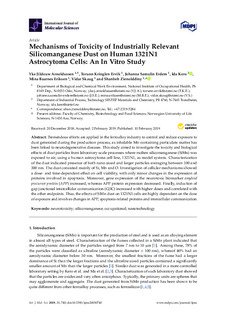| dc.contributor.author | Arnoldussen, Yke Jildouw | |
| dc.contributor.author | Ervik, Torunn Kringlen | |
| dc.contributor.author | Samulin-Erdem, Johanna Maria | |
| dc.contributor.author | Kero, Ida | |
| dc.contributor.author | Eriksen, Mina Baarnes | |
| dc.contributor.author | Skaug, Vidar | |
| dc.contributor.author | Zienolddiny, Shanbeh | |
| dc.date.accessioned | 2019-12-13T09:28:49Z | |
| dc.date.available | 2019-12-13T09:28:49Z | |
| dc.date.created | 2019-02-15T13:01:51Z | |
| dc.date.issued | 2019 | |
| dc.identifier.issn | 1422-0067 | |
| dc.identifier.uri | http://hdl.handle.net/11250/2633099 | |
| dc.description.abstract | Tremendous efforts are applied in the ferroalloy industry to control and reduce exposure to dust generated during the production process, as inhalable Mn-containing particulate matter has been linked to neurodegenerative diseases. This study aimed to investigate the toxicity and biological effects of dust particles from laboratory-scale processes where molten silicomanganese (SiMn) was exposed to air, using a human astrocytoma cell line, 1321N1, as model system. Characterization of the dust indicated presence of both nano-sized and larger particles averaging between 100 and 300 nm. The dust consisted mainly of Si, Mn and O. Investigation of cellular mechanisms showed a dose- and time-dependent effect on cell viability, with only minor changes in the expression of proteins involved in apoptosis. Moreover, gene expression of the neurotoxic biomarker amyloid precursor protein (APP) increased, whereas APP protein expression decreased. Finally, induction of gap junctional intercellular communication (GJIC) increased with higher doses and correlated with the other endpoints. Thus, the effects of SiMn dust on 1321N1 cells are highly dependent on the dose of exposure and involves changes in APP, apoptosis-related proteins and intercellular communication. | nb_NO |
| dc.language.iso | eng | nb_NO |
| dc.publisher | MDPI | nb_NO |
| dc.rights | Navngivelse 4.0 Internasjonal | * |
| dc.rights.uri | http://creativecommons.org/licenses/by/4.0/deed.no | * |
| dc.subject | neurotoxicity | nb_NO |
| dc.subject | silicomanganese | nb_NO |
| dc.subject | occupational | nb_NO |
| dc.subject | nanotechnology | nb_NO |
| dc.title | Mechanisms of Toxicity of Industrially Relevant Silicomanganese Dust on Human 1321N1 Astrocytoma Cells: An In Vitro Study | nb_NO |
| dc.type | Journal article | nb_NO |
| dc.type | Peer reviewed | nb_NO |
| dc.description.version | publishedVersion | nb_NO |
| dc.rights.holder | This is an open access article distributed under the Creative Commons Attribution License which permits unrestricted use, distribution, and reproduction in any medium, provided the original work is properly cited | nb_NO |
| dc.source.volume | 20 | nb_NO |
| dc.source.journal | International Journal of Molecular Sciences | nb_NO |
| dc.source.issue | 3 | nb_NO |
| dc.identifier.doi | 10.3390/ijms20030740 | |
| dc.identifier.cristin | 1677676 | |
| cristin.unitcode | 7401,80,63,0 | |
| cristin.unitname | Metallproduksjon og prosessering | |
| cristin.ispublished | true | |
| cristin.fulltext | original | |
| cristin.qualitycode | 1 | |

